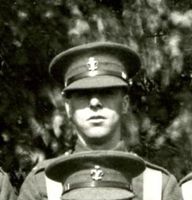
Photograph of Edwin in Tameside Local Studies and Archives Centre. Reference:MRP/5D/069

(L to R) General Service Medal 1918-62 with clasp 'Palestine'; 1939-45 Star; Pacific Star; 1939-45 Defence Medal; 1939-45 War Medal; Long Service and Good Conduct Medal; 8th Battalion Shooting Medal
Edwin was born on the 3rd August 1910 in Reddish in Stockport, Cheshire. His father was called Isaac and his mother was Annie. We know he had 2 older sisters: Isabella and Grace.
In 1911 Isaac was self employed as an insurance agent and the family lived at 31 Carna Road in Reddish. We don't know anything about Edwin's early life.
On the 29th April 1930 Edwin joined the 8th Battalion of the Manchester Regiment. This was a unit of the Territorial Army based in Ardwick, Manchester. Edwin kept his civilian job and trained as a soldier during evenings and weekends. He was given the service number 3524261. Edwin won his shooting medal in 1931. By 1933 he was working as an iron turner, cutting metal in a factory.
Edwin must have taken to Army life, because on the 14th March 1933 he gave up his civilian job and joined the Regular Army. He decided to stay in the Manchester Regiment and trained at their Regimental Depot in Ashton-under-Lyne as a member of Guadaloupe Squad under the command of Sergeant Smart.
When he enlisted Edwin was 5 feet 7 inches tall. He had a 'fresh' complexion, blue eyes and brown hair. He had a scar on the right side of his neck. During his training he obtained the 3rd Class Army Certificate of Education on the 18th July.
After he had completed his training in September Edwin joined the 1st Battalion in Gosport, Hampshire. They left the UK to serve in the West Indies on the 23rd January 1934. The battalion was split between Jamaica and Bermuda during this posting, and we don't know where Edwin was based. He obtained his 2nd Class Certificate of Education on the 18th July 1935. The battalion left the West Indies in September 1935 and was sent to Egypt.
Tensions between the UK, who ruled Egypt, and Italy, who ruled neighbouring Libya, were rising during this period. Edwin and the 1st Battalion took part in patrols of the border, and trained to operate from vehicles rather than on foot. After the situation calmed during early 1936 Edwin returned to barracks in Moascar.
During 1937 the 1st Battalion converted from an infantry unit to a mechanised machine gun battalion. This meant soldiers needed to be trained in driving, vehicle maintenance and machine gun shooting as well as maintaining all their other skills.
No sooner was the battalion retrained and reorganised than everything had to be reversed. The 1st Battalion had been ordered to move to Palestine and serve as an infantry unit. A rebellion had broken out amongst several of the Arab tribes living in this colony, and the British needed more soldiers to bring it under control. Edwin served there between the 14th January and the 23rd September 1938. The 1st Battalion was based in the area around the city of Acre. Their roles were to search for gangs of rebels, to patrol villages and the countryside and to guard important areas against attack.
After serving in Palestine the 1st Battalion moved to Singapore. They began to build defences and train to resist an invasion. Their main role was to man pillboxes on the beaches of the island. Edwin was promoted twice during his time in Singapore, to Lance Corporal and then to Corporal.
By 1941 war with the Japanese was becoming more and more likely. They invaded Malaya on the 8th December, and by the 27th January 1942 the British had been forced back onto the island of Singapore.
We believe that Edwin was a member of Headquarters Company when the Japanese invaded. By the end of January the British were being constantly bombed, and as the Japanese closed in their position became hopeless. The British garrison surrendered on the 15th February and Edwin became a Prisoner of War (POW).
Edwin was held in MacArthur Camp in Singapore between the surrender and the 16th November 1942. He was then moved to Changi Prison in the east of the island, where most of the 1st Battalion was being held along with tens of thousands of other Allied POWs.
Throughout the rest of the war many thousands of POWs were taken from Changi to Thailand and Burma. They were then put to work building the Burma railway for the Japanese. This did not happen to Edwin. He stayed in Changi until July 1944. Conditions in Changi were far from pleasant. The camp was overcrowded and there were shortages of food and medical supplies. However the POWs held there were able to stay fairly healthy. Edwin was not exposed to the tropical diseases, hard work and brutality that killed so many POWs in the Burmese and Thai jungle. POWs who worked on the railway thought of Changi as relatively pleasant in comparison.
On the 26th July 1944 Edwin was moved to Normanton Camp in the south of Singapore. He was held here until the 4th August 1945 when he was admitted to Kranji Hospital in the north of the island. Although this suggests Edwin had fallen ill, we don't know anything about his condition. He was still in hospital in early September when the Allies landed in Singapore and the Japanese surrendered.
Edwin had returned to the UK by the 10th October. He was released to the Army Reserve on the 22nd May 1946, which meant he could return home to find work. We don't know where he had been between October and May. When he left the Army his conduct was described as 'exemplary'. Edwin was 'a good soldier who is thorough, reliable and trustworthy. He is a good willing worker and has made a useful NCO. He is confidently recommended for employment and would be suitable for a position of trust.'
Although Edwin had found work as a labourer, he must have missed the Army, because he reenlisted on the 18th September 1946. He rejoined the Manchester Regiment and served for almost 9 years. We don't know much about what Edwin did during this time, but we believe he spent most of it at the Regimental Depot in Ashton. He never left the UK during his second period of service.
Edwin was presented with the Long Service and Good Conduct Medal at Ladysmith Barracks on the 17th September 1952. This recognised Edwin's 18 years in the Army. He was finally discharged on the 10th July 1955. Again, his conduct had been 'exemplary'. He was 'honest, sober, trustworthy. He works well without supervision. He should do well in a job of trust such as a storeman. He is very interested in his work and would like to join the Corps of Commissionaires - a job for which he is well suited'.
The Corps of Commissionaires was made up of ex-servicemen. It provided doormen and security guards for Government buildings. We don't know whether Edwin did go and work for them.
We don't believe Edwin ever married or had children. He died in Manchester between January and March 1970 at the age of 59. His medals were donated to the Museum of the Manchester Regiment in February 1999.




